The Pool Is Fun — Now Put One in Every Damn Ballpark
Scribbled Notes: A Splash Landing in Las Vegas, remembering the Gregg Jefferies pool workout, the spray hitter named Puhl, the Romo you can't heckle
Scribbling from the Master Planned Community of Summerlin1
I’m typing most of this week’s “Scribbled Notes” from the swimming pool at the Red Rock Hotel and Casino, one night after describing a home run that landed in a swimming pool, I’m thinking about famous moments involving baseball and water, and we need to normalize this double play combination.
Ballparks were built next to large bodies of water for a long time, but architects never thought to incorporate the water into the design until the last 30 years. It’s really crazy that Riverfront Stadium and Three Rivers Stadium existed, yet you couldn’t see either river.2
When the expansion Arizona Diamondbacks debuted in 1998, they installed a pool behind the fence in right-center field that fans could rent out for a game. The idea started as an off-hand comment by designers from Chicago who remembered the shower that existed at the old Comiskey Park — then it turned into reality.
San Diego State alum Mark Grace hit the first “splash” home run into the pool in the game3 and it was the “ohhhh yessss” moment for future ballparks — major and minor.
In 2000, the Giants opened their gorgeous ballpark on the shores of San Francisco Bay. It wasn’t a pool that could be rented, but fans quickly realized they could enjoy the game in a unique way and showcase their individualism.
Naturally, Barry Bonds launched the first “splash hit” into the Bay. Initially, boats with engines were in the area dubbed McCovey Cove. Video of the “Splash” home run showed the potential for disaster. Two motorized boats rammed into each other. Those vessels were outlawed. Now it’s just kayaks and some surfboards. I’ve done it twice and highly recommend it.
Depending on your definition of a swimming pool, minor league ballparks that feature a pool include here in Las Vegas, Frisco (TX), Corpus Christi (TX), Reading (PA) and Fresno (CA).
I’m extremely jealous of the lazy river at Frisco. Sam Dykstra from milb.com did some hard-hitting reporting on his recent trip to Riders Field and almost caught a home run in the process.
In the PCL, we used to have teams in New Orleans and Colorado Springs that featured either a pool or hot tub.
I once saw manager New Orleans Zephyrs manager Ron Hassey throw batting practice and hit fungos, then walk over to the pool, take off his shirt and jump in. Initially, he was heckling his own players before they realized it was their own manager watching the rest of batting practice from the pool that went right up against the outfield wall.
In the Springs, I was told the hot tub was more popular early in the season when it was cold, moreso than the hot summer months.
Round Rock used to have a pool, it was pretty far from the outfield wall, but got rid of it as part of ballpark renovations that included a new visitors clubhouse. I was told the cleanup and liability weren’t worth it and they needed the space.
Fresno used to have a pool so small it was easy to miss, then smartly transformed an area in right field into a larger pool with other water playground elements. It’s rad.4
The specific designs for the A’s new ballpark in Las Vegas, at the old Tropicana casino site, are still scarce. They’re missing out if they don’t include a pool. Heck, I’d made it a multi-level tier of pools stacked on top of each other.
I know, it’s easy for me to say. I’m not the guy who has to cleanup a swimming pool or worry about the liability when somebody does a cannonball into the pool, but I’d put a swimming pool in every ballpark.
Most fans care more about a memorable ballpark experience than watching every pitch. Pools at ballparks are reserved for every game, way in advance. You can use the pools for non-gameday events too.
The planet is getting hotter5 and it’s not going to stop. I don’t think anyone has ever regretted their decision to rent a pool at a ballpark.
Ballparks new more swimming pools, not fewer.
👋 For new readers, “Scribbled Notes on a Cocktail Napkin” is my weekly Sunday feature that's a tribute to the sports columnists I grew up reading who penned Herb Caen-inspired three dot columns. It's an excuse to shamelessly plug my other side projects, post my favorite Immaculate Grid from the week with a story about one of the players, link to stories I found interesting, and string together whatever topics were on my mind this week.Gregg Jefferies, the ultimate pool boy
Out of the all the rookie baseball cards I collected in the 1980s, I was most convinced Gregg Jefferies cards were going to make me rich and he was destined for the Hall of Fame based on the following reasons:
Jefferies was from the Bay Area and I thought everyone from my region was destined for superstardom.
I once convinced my Dad to take us to a “Hot Stove” banquet, where Jefferies received a Minor League Player of the Year award, and I got Jefferies’ autograph on two precious minor league baseball cards.
This swimming pool photo.
Jefferies’ offseason workouts were unheard of, at the time, as documented in the Jill Lieber profile in the March 21, 1988 issue of Sports Illustrated.
Around 11 am, Gregg returns home to do batting exercises in the family's 45-foot-long backyard pool. Standing chest deep, Jefferies takes 50 swings each way, pulling his bat through the water as smoothly as possible. Then, holding the bat fully immersed, he lifts it up and down 20 times with each hand, often struggling to wrench it to the surface.
Next he runs—or thrashes—10 laps in the five-foot-deep pool, lifting his knees as high as he can. Then he swims another 40.
I vividly remember reading that article and going to the community pool of our condo, bat in hand, ready to do the same workout as Jefferies. I arrived cocky. I left demoralized. Swinging a baseball bat in the pool is really difficult.
Jefferies was a two-time All Star, collected 1,593 hits over 14 years in the majors. But he’s mostly remembered for not accomplishing even more.
Five years ago, respected baseball writer Joel Sherman wrote a story for The New York Post about how Jefferies’ complicated Mets failure looks different in a modern lens. The veterans didn’t like the cocky kid, so they bullied him. It hurt Jefferies’ career and hurt the Mets.
Here’s a few of the key passages.
“He was revolutionary in what he did,” pitcher Ron Darling says now. “The archaic, Neanderthal part of baseball was not ready to accept that. A lot of animosity from that Mets team came from players not willing to grow and change. … He was not allowed to thrive in the way he should have. In retrospect it is a black mark on the team.”
…
Sending Gregg Jefferies to the 1988 New York Mets was like sending a choirboy to Sing Sing. The team had mainly been together for five years, played hard, lived harder, fought among each other but fought outsiders with more ferocity. The infighting, if anything, strangely strengthened the internal loyalty.
…
“It was the roughest group to break in with, the Mets of that era — tough as they come,” Cone said. “We self-policed and we ran rookies hard. It was a different generation of players. … The veterans were hard on him. Once you were on the wrong side with that group it was impossible to recover.”
After his career ended, he moved to the East Bay and actually coached at my old high school, Foothill High in Pleasanton, for a few years.
Based on this post from Jefferies on Twitter two years ago, and all the fun responses, I’m not the only person who remembers the swimming pool photo, failed attempts at swinging a bat in the pool, and thought his rookie cards were going to make us rich.
This week’s Immaculate Grid story: Terry Puhl
Terry Puhl never hit a home run into a swimming pool and was not a pull hitter.
He was one of the first baseball stars from Canada, a spray hitter who played 14 consecutive years with the Houston Astros, becoming the longest-serving active one-team player in the National League at one point.
Some players start their pro careers and then return to a campus to obtain a college degree. Puhl returned home from his first year in pro ball and finished high school.
“I left the 12th grade with one semester to go and went away to spring training,” Puhl once told a reporter. “Then I returned to Melville and finished school after playing in the Rookie League.”
Puhl was undrafted, signed by an Astros scout for $1,000 to play outfield (a position he’d never played before), and was in the major leagues three years later at age 20. He was an All Star in his second year and the best player on the 1980 team that reached the playoffs.
“You can’t quote a smile,” a Cincinnati writer once said after interviewing Puhl. At age 24, the most comparable player to Puhl’s career was Roberto Clemente. He batted .526 in the 1980 playoffs and was among the best players in the sport.
Injuries prevented him from becoming a superstar, but he still played 15 years, and was inducted into both the Astros Hall of Fame and the Canadian Baseball Hall of Fame.
Update on my summer reading challenge
I know you’re all riveted if I’ve been able to maintain my challenge of reading one book on every road trip. Yes, I’m still going strong. I even read a book on the last homestand to makeup for the book I didn’t read on an earlier roadtrip.
I’m up to six completed books. These two are my latest.
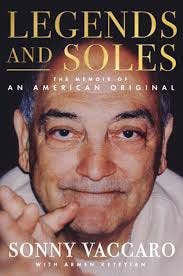
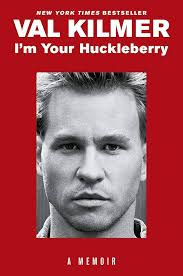
My favorite line from Val Kilmer’s memoir: “God wants us to walk, but the devil sends a limo.”
On accident, my summer reading has turned into supporting San Diego State alums.
The Sonny Vacarro memoir was co-written by fellow Aztec alum Armen Keteyian.
Now I’m reading “Generations” by Jean M. Twenge, PhD. I didn’t know until the final chapter that Twenge is a professor of psychology at SDSU too.6
The Splash heard ‘round Summerlin
Shameless plug alert: here’s my call of the Drew Romo home run into the pool in Las Vegas that inspired this entire post.
The best part is the reaction of the adults who were oblivious that a ball was coming directly at them and then surprise when it lands in the water.
Since I’m sure the name Romo made you think of it, let me answer your questions:
Nope, he’s not related to Tony Romo.
Yes, fans always heckle him and call him Tony.
Nope, he doesn’t mind.
His friends call him Tony for fun, so he treats any “heckle” like it’s one of his friends in the stands cheering for him.
When the Triple-A Las Vegas team moved from Cashman Field downtown, I mistakenly referred to the city as Summerlin. I was told it’s still in the Las Vegas city limits, it has a Las Vegas address and zip code, and that it’s “the master planned community of Las Vegas.” I use the phrase on the air all time, 50% out of respect and 50% to mock it.
I’ll always believe the decline in baseball’s popularity in the 1970s was, in large part, because so many of the ballparks were these concrete donuts that all looked the same and had no personality. Note to self: write about this in the offseason.
Mark Grace was still playing for the Cubs for the first splash homer in Phoenix. He joined the Diamondbacks three years later.
See, I don’t always say mean things about Fresno.
Even though it was over 100 degrees, Las Vegas was somehow not the hottest place to watch a baseball game this week.
Of course I skipped ahead immediately to the chapter on GenX. Still up for debate if I’m going to read about you Silents, Boomers, Millennials and GenZers. The book is due back at the library soon.








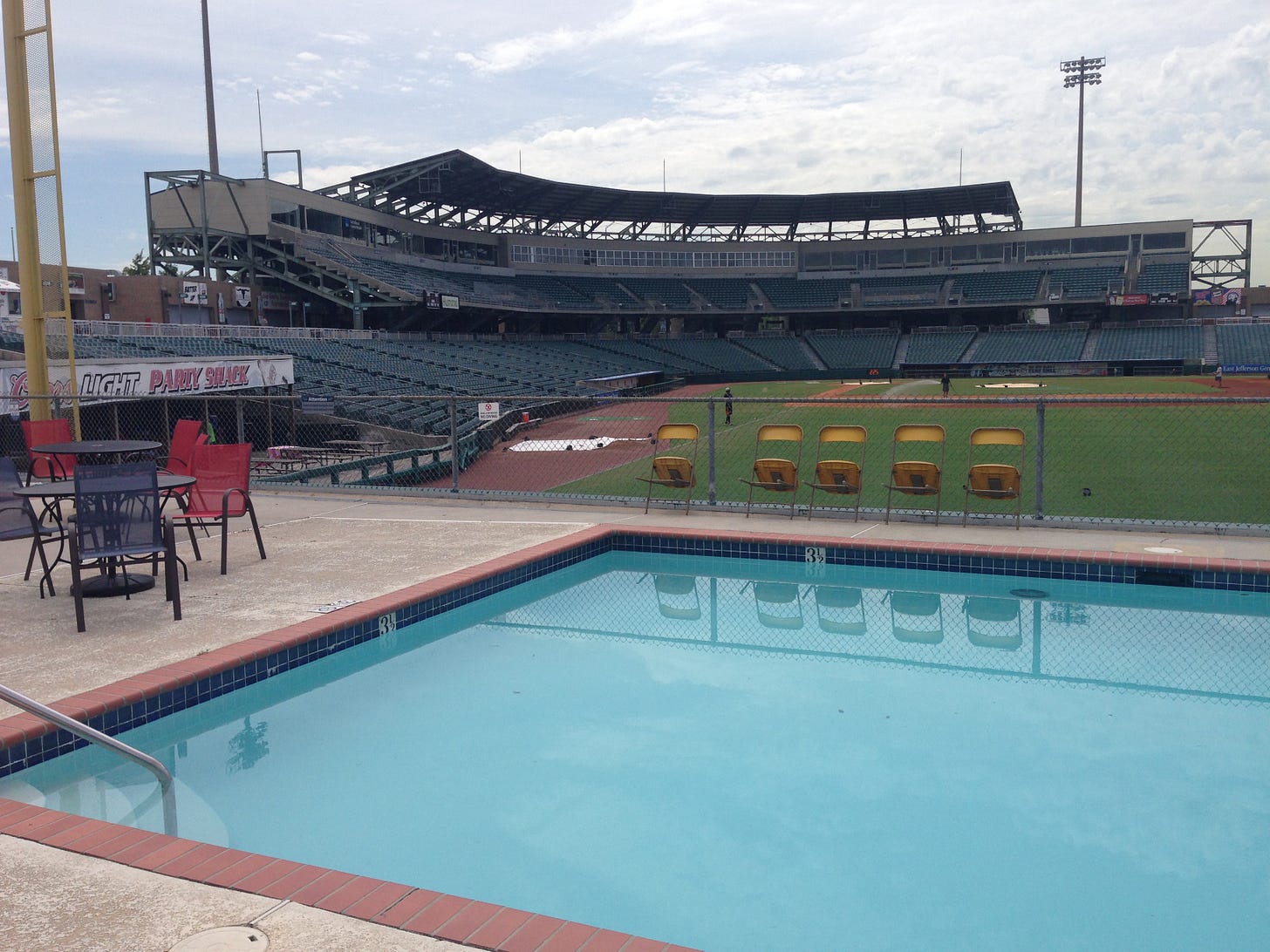

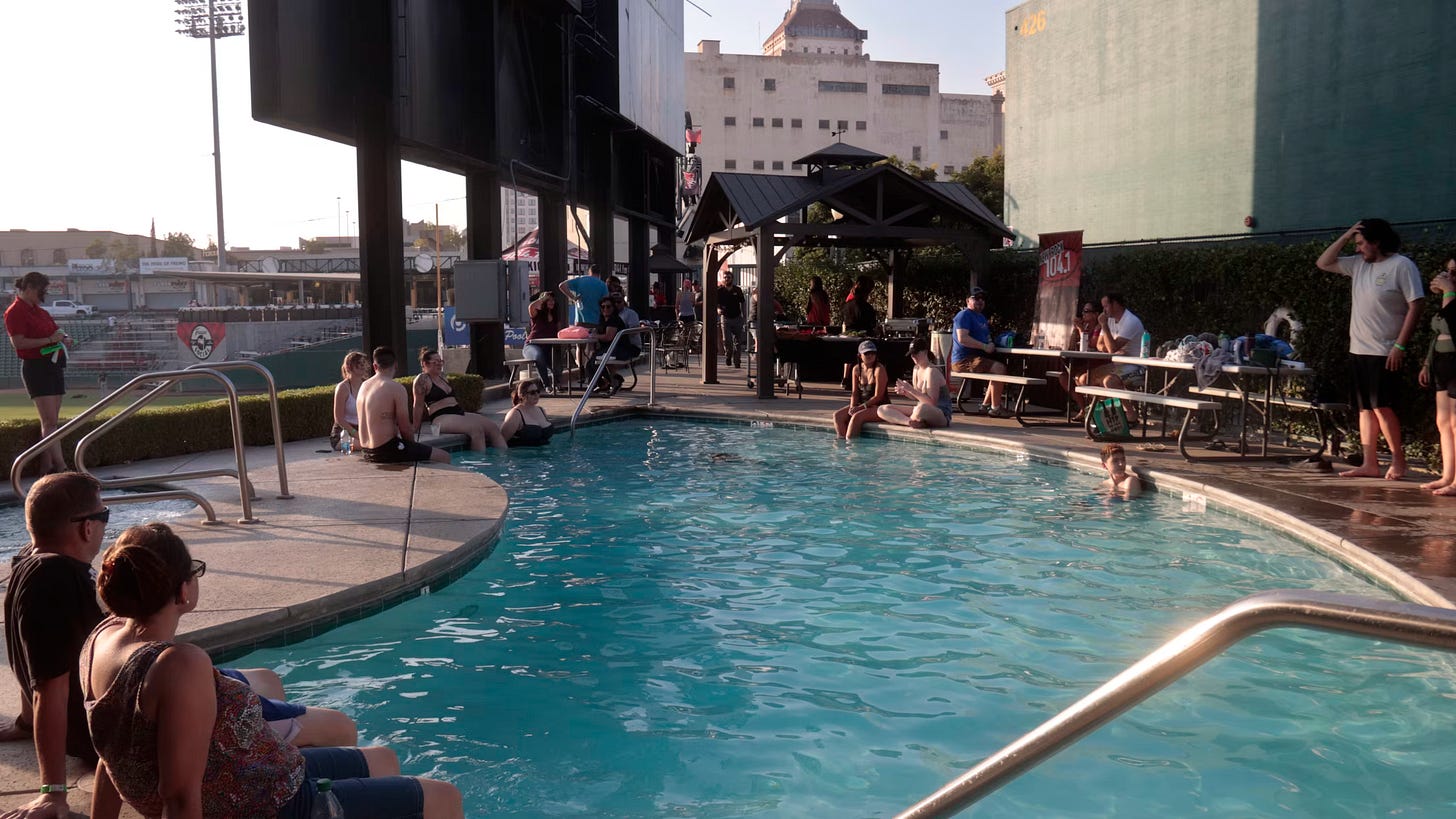
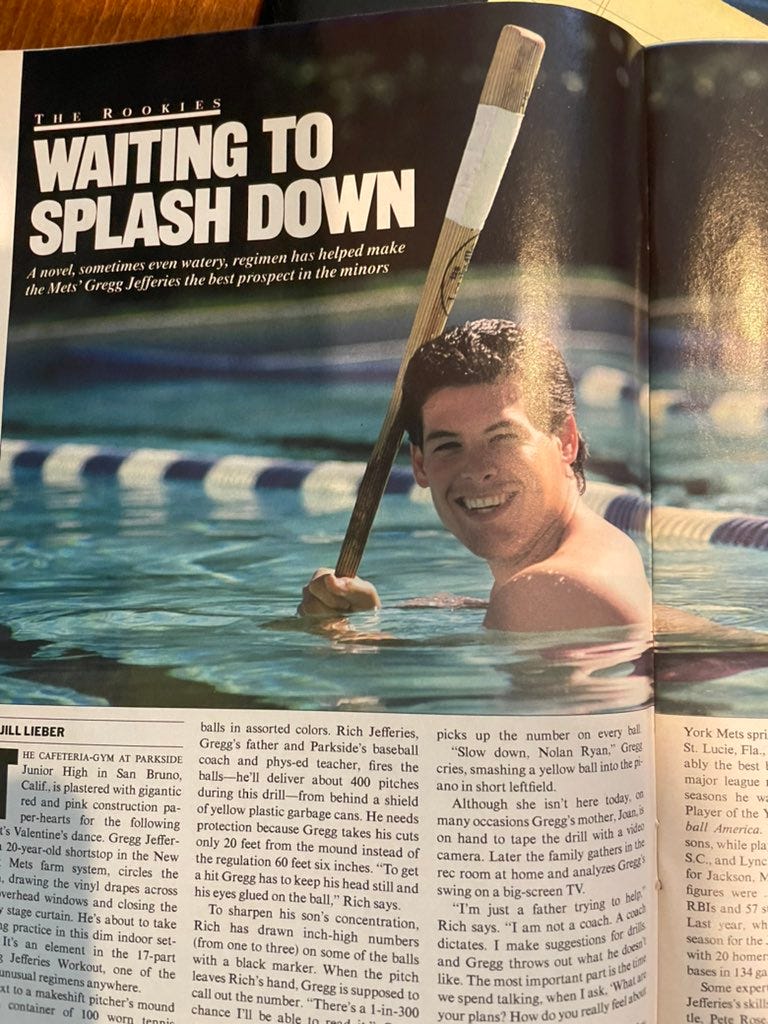






I was at Riders Field two nights before you published this. It is a SCENE out there on the Lazy River. We went to check it out and the smell of Banana Boat hits you about 50 feet before you reach the entrance. I couldn't see much current or floating going on in that river, but it was packed with people of an age that I'm sure the Rough Riders and baseball very much wants to capture. A very cool park all the way around.
I love the Aviators stadium in Vegas, out there every summer because of family and is my go to place.